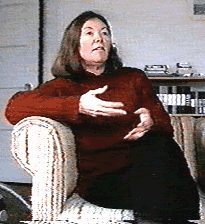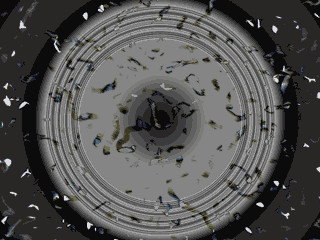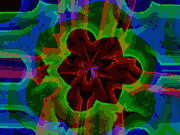



Carol Goss started the Not Still Art Video Festival in the spring of 1996 which is where I first encountered her. Invited to speak as a panelist about my video work producing OffLine, I quickly discovered that the kind of abstract work I'd been doing for several years has been around since about 1968. Carol comes out of a background in theater and music and a family of performing jazz musicians. Early on, she got involved in directing theater for television and was interested in using video for live performance. After a negative experience working with film in which she vowed to never again work with film, Carol turned to video and decided to document a musical performance by William Burroughs and Paul Bley. She later met Nam June Paik who suggested she check out the Experimental Television Center. That was in 1974.
The fascination with the pixel began there at the center. Driven away from linear, narrative content, she investigated the visual possibilities of the video medium. The mandala-like quality of some of the imagery created a kind of spiritual significance for her which still holds interest for her. The equipment at ETC was exciting for her to experiment with. The Paik/Abe synthesizer had a habit of never doing the same thing twice, as if by magic.
No stranger to theater, Carol became interested in using video in performance. She started the Improvising Artists group with the mission of recording music and video. They would record LP's of avant garde jazz and would set up video synthesizers at the same time and improvise along with the music. A few years later in 1977 they set up a performance of jazz and video at Axis-in-Soho in New York with Walter Wright on video, and Sun Ra and his Arkestra doing music, along with Paul Bley and Glen Moore. Additional performances in 1978 expanded on this basic paradigm of live video and music improvisation. Carol recalls that first performance with Sun Ra. They began the night with a microphone and headphone system so that the video crew could communicate with each other (an industry standard for live coverage of events in television). Within a few songs, they had discarded the micropohones and headphones and decided to do everything on the fly. There were inspired by the free nature of the music and felt that the video crew should have the same freedom as the musicians instead of being chained down to a system of control that made little sense in that environment. And so began the video improvisation.
A strong interest in video and improvisation makes the video medium exciting for Carol. She has spent a great deal of time thinking about performance and she written numerous essays on the subject. "Traditionally theater has been scripted" she points out. It isn't until the mid 20th century that improvisation within theatrical performance becomes commonplace. There are earlier areas of improvisation, but these tend to be more in the area of comedy, such as commedia dell'arte which developed in Italy using the mid 16th century. Featuring both scripted and improvised speech, tumbling and acrobatics, it served as one of the earliest forms of improvisational theater.
With improvisation, the key area of focus is on the performer and their own creative process. Scripted pieces solve all the problems before the work is ever shown, but improv work tends to highlight the problem-solving process itself as art form.
"What distinguishes performance from other contexts where you can work. One of the things that distinguishes live performance is that it's collaborative. It doesn't have to be collaborative. But if you use music as a kind of template, jazz in particular which has a hundred year history of improvisation on stage in front of audiences, it's considered a conversation."
Working with performance means working with limitations. In the studio, you can do anything you want. You can redo sections endlessly until you get them the way you want them. In performance, everything is compressed in time, so you have to limit yourself in terms of the tools you use and what you can accomplish with them in the given time frame.
"If what you¼re going to do is scripted, then you can do it over and over again, or you can robotize it. Or you can play a prerecorded tape where you already did it. Maybe you did it best when you did it the first time. Why do it again? You do improvisation and live performance because you're going to have an experience you haven't had before. And hopefully from that experience you will learn something that will be useful."
The comparison to live music is inevitable. With the early video artists, there was no previous history of the medium, and all the people working in it had come out of a variety of other arts backgrounds including music and theater, so there was a sense that video would simply extend the principles of other performative media into the realm of video, as though it was supposed to be performed. After all, with the live camera, it made sense to do something live in performance.
Many video art performers have made the analogy between music groups and video groups, since the collaborative environment created in both situations is so similar. Video groups often create pieces the way bands write songs, rehearse the work, and then these pieces are played live in concert. Other pieces are created more in the moment, the way an experimental jazz group might work.
 "Live performance for media is problematic," Carol notes, because of the technical considerations in set-up and presentation, and also in terms of how long the audience can endure such work. Consider that some of the early performances of Tony Conrad were designed to drive the audience from the space - many early works also wrestled with such difficult conceptual issues, making them harder for an audience to grasp. Carol tends to work with live camera feeds whenever possible. It's one of the easier things for an audience to figure out, and its possibilities in performance seem limitless. She finds that using prerecorded materials can also be problematic for the audience - again it presents the question of who is doing what, what makes the actions on stage interesting for the audience. And yet many video performances make use of such materials, so there is certainly the enthusiasm on the performers' part to embrace it in the show. Part of the difficulty lies in knowing what to expect, and the tape always shows the same thing in the same order. Some performers such as Steina Vasulka get around this obvious problem by moving to a non-linear form of control using videodisk technology to allow random access of specific points on the disk. Granted, you know all the material on the disk, but the possibility or re-presenting that material live in a variety of ways opens it up for performance.
"Live performance for media is problematic," Carol notes, because of the technical considerations in set-up and presentation, and also in terms of how long the audience can endure such work. Consider that some of the early performances of Tony Conrad were designed to drive the audience from the space - many early works also wrestled with such difficult conceptual issues, making them harder for an audience to grasp. Carol tends to work with live camera feeds whenever possible. It's one of the easier things for an audience to figure out, and its possibilities in performance seem limitless. She finds that using prerecorded materials can also be problematic for the audience - again it presents the question of who is doing what, what makes the actions on stage interesting for the audience. And yet many video performances make use of such materials, so there is certainly the enthusiasm on the performers' part to embrace it in the show. Part of the difficulty lies in knowing what to expect, and the tape always shows the same thing in the same order. Some performers such as Steina Vasulka get around this obvious problem by moving to a non-linear form of control using videodisk technology to allow random access of specific points on the disk. Granted, you know all the material on the disk, but the possibility or re-presenting that material live in a variety of ways opens it up for performance.
There is something magical about performance for Carol. Not just magical in the sense of that experience of being in the moment in front of an audience, but also in terms of the medium. The equipment itself would often do unpredictable things (as many of the early analog video devices were inclined to do). The Paik/Abe synthesizer was a constant source of magic in that it could not be made to repeat any effect you might discover, so there was no relying on set gestures and images.
"Magic is what you can't figure out. The things I still like doing with old tech are the things that I can't figure out. For example, at the Tools Room at the conference, everyone speaks glowingly of the Paik/Abe, because it did things that no one knew how it did it. Things it wasn't supposed to be able to do."
The toughest part of the equation for video in performance lies with the audience's understanding and enjoyment of the work. Performers have little trouble enjoying the work they are doing, but making it accessible to an outside audience presents certain challenges. The audience needs something to identify with, such as familiar images, a narrative structure, or personal storytelling, to name a few. As an experiment while showing some tape at AIR in New York, she tried to hide her identity on the tape. Even so, she said she could tell it was her work. It's pretty hard to erase your identity in your work.
In curating the Not Still Art Festival, Carol found that audience members were more comfortable with watching the videos during the screening part of the festival than with the live performances. There is something about the television-watching activity associated with the screening that makes it more accessible for the audience, even when the work itself is more experimental or unusual than what they might see in concert.
Part of the problem lies in the history of the medium, of which there is very little right now in 1998. Having only been utilized for art-making purposes since the late 1960's, video is still growing up. Carol assesses the situation as one of needing more time. When the electric guitar was first introduced, nobody played guitar that much. Now 50 years later, several million people subscribe to Guitar Player magazine, and there are millions of guitar players in millions of bands. And so the expectation is that in time, video will enjoy the same ubiquitous status as another instrument for the everyday artist.
The other part of the problem stems from the non-live nature of most video work. Recording technology made it possible to create visually dazzling works in a studio setting which allowed for a greater degree of control than could be had in a live recording situation.

"150 years ago, before there were records, before there was radio, every town, every village, had live music every weekend. Now that was a lot of musicians working. And what happened was with the advent of recorded music, there were fewer and fewer people working. There's just a handful of people that can make a living at it who can be asked to perform and everybody else is like a passive viewer."
"I don¼t perform that much because of the hassle. I'm not trying to bring people in so that the sponsors feels happy, etc. I look at it as an opportunity for me to try something I've never done before."
Whether or not video performance will gain more stature and acceptance remains to be seen. A lot of the work being performed tends to be abstract, staying away from the narrative structure, which can be a challenge for the audience. She argues that abstraction tends to be a private thing,, trance-like, a lonely activity between you and the screen. The ideal place for such work is in your home, where the viewing can be a private one on one experience with the material.
So how can video performance work, specifically abstract material, become more accessible to the audience? Galleries and museums tend to look for installation-based works. "How can you get single channel video back into the museums?" asks Carol. "You'd have to make them installations. Which is problematic if the work was intended to be single channel and must be reconfigured to fit within the museum's curatorial framework.
Single channel works fares better on television, but other issues arise in terms of length and content. Television seeks a range of shorter videos, not because of the shorter attention spans of today's audience, but out of a need for variety. The variety is demanded for a group context where there may be many different points of view within the audience, and a group of shorter works may reach out to a larger audience better than a single work can.
Ultimately we are left to ponder the position of the performing artist in a technological context. Each performer must decide on the formula that works for them personally. Until video has a more established history, it is up to the artists of today to create that history and to set some precedents, hopefully in order to create more widespread acceptance and understanding of video in general. Attention to the pixel may be that first step.
"We did not come out of an educational system that was reflecting on video art as having a history because it didn't. So we all came from different backgrounds. We were reacting to the screen, just the surface of the screen. That was our primary preoccupation. There has been so much time and energy spent with representation, that even now when people do abstraction, they're obsessed with what is being represented and abstracted. It's like they're going back two layers. As opposed to just dealing with the pixels, the texture, the light that's there."